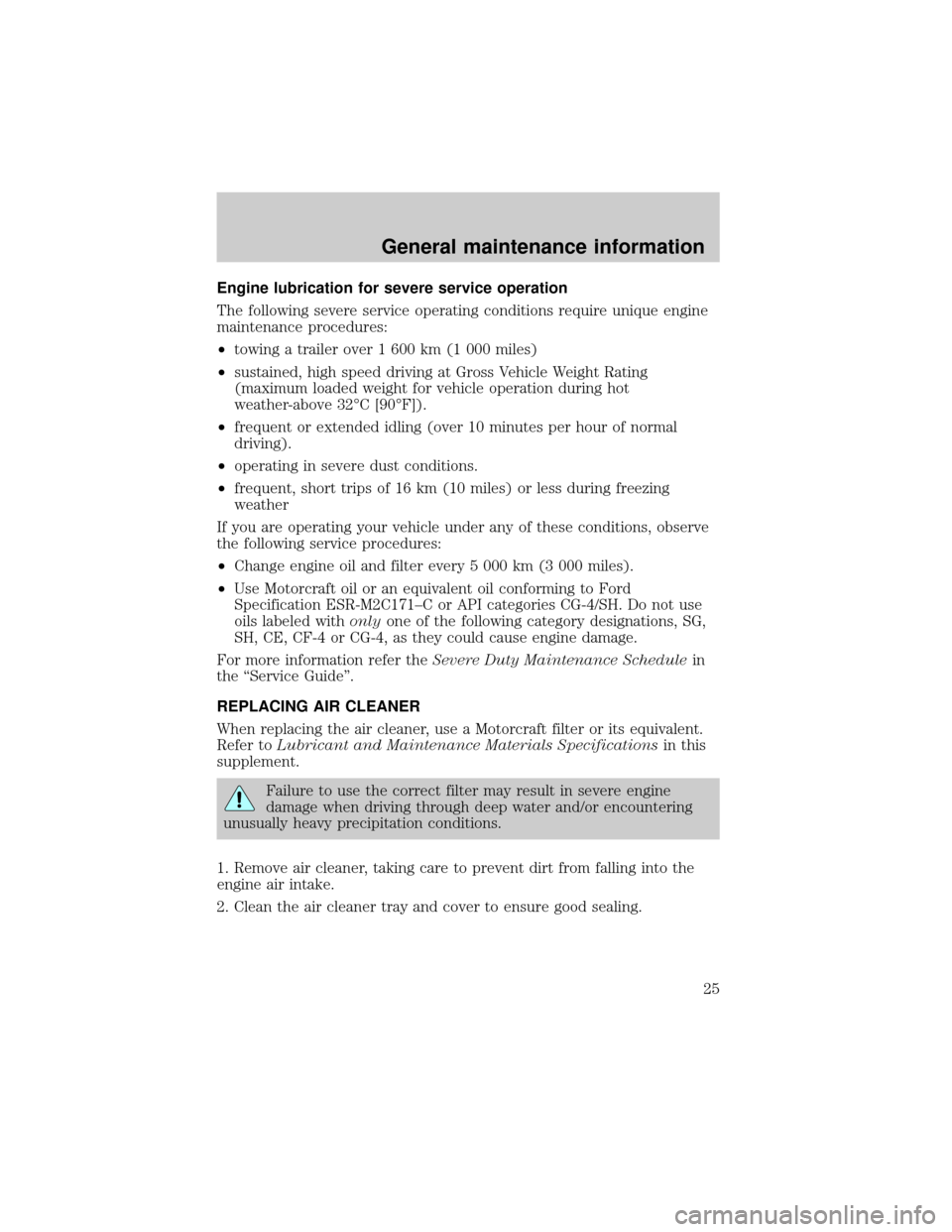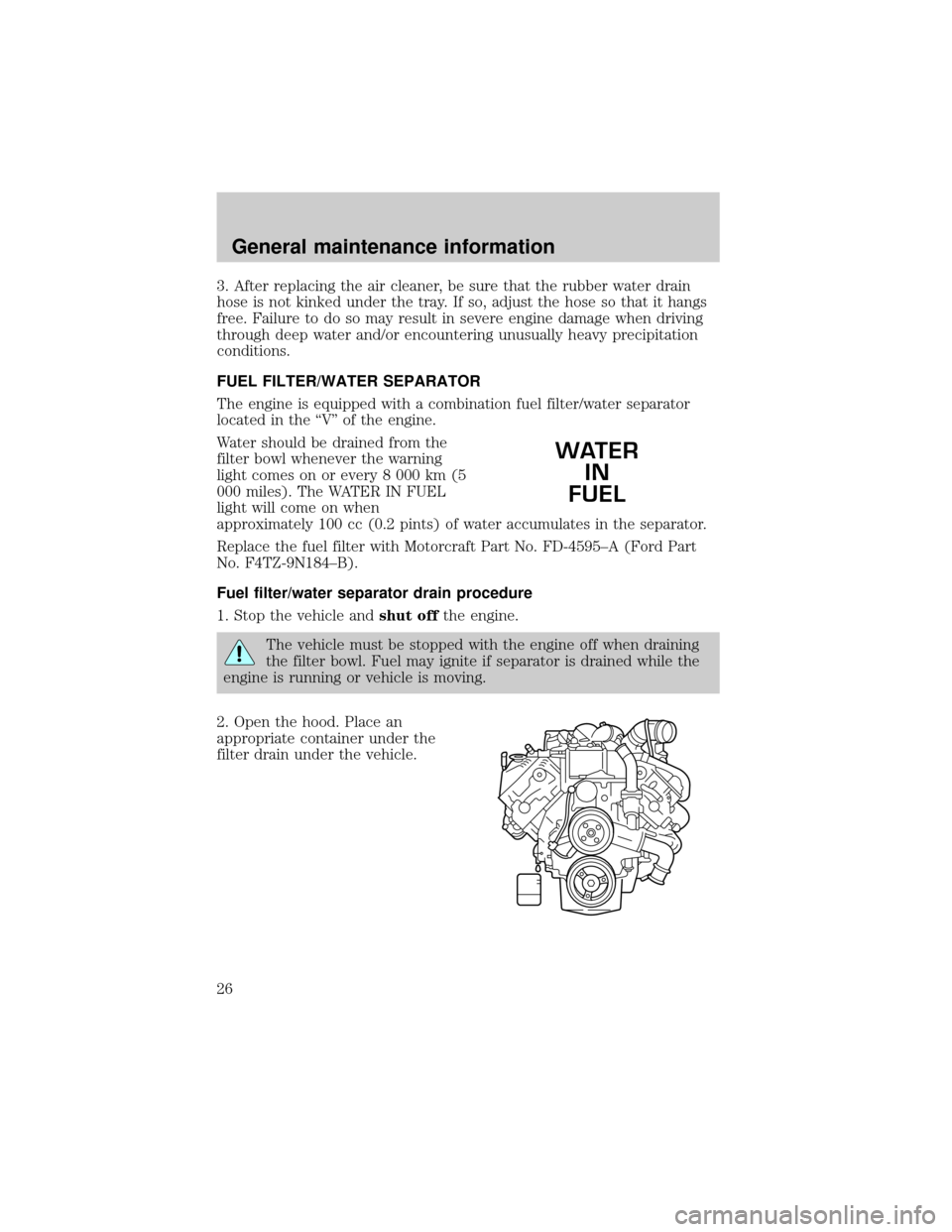1999 FORD E SERIES air filter
[x] Cancel search: air filterPage 6 of 39

Air filter restriction gauge
The restriction gauge, located on
the clean-air side of the air cleaner
upper housing, shows if the air filter
is clogged.
The air filter element should be
replaced when the yellow band on
the gauge reaches the CHANGE
FILTER mark. Engine performance
and fuel economy are adversely
affected when maximum restriction
is reached. After servicing the air
filter element, reset the restriction
gauge by pressing the button the
end of the gauge.
AIRFILTERGAUGECHANGEFILTERCHANGEFILTER
AIRFILTERGAUGECHANGEFILTERCHANGEFILTER
Diesel information
6
Page 8 of 39

WAIT TO START
With the key in the ON position, the
WAIT TO START light will illuminate
if glow plug heat is necessary as a
starting aid. Wait until the light goes
off before starting. The light should
always illuminate briefly, when the ignition key is in the ON position. If
the light does not illuminate, there may be a problem. Refer to the
Startingchapter in this guide. After the engine starts, the light should
remain off.
The light should always illuminate at least momentarily when the engine
is cold and the ignition is turned to ON. If it does not illuminate, the
glow plug system should be checked and repaired promptly to avoid
difficulty in cold starting.
WATER IN FUEL
During refueling, it is possible for
water-contaminated diesel fuel to be
pumped into your tank. Your vehicle
fuel system is equipped with a fuel
filter/water separator to remove
water from the fuel. The WATER IN FUEL light will illuminate when the
ignition is turned to START (as part of the light function check) and
when the fuel filter/water separator has a significant quantity of water in
it.
If the light illuminates when the engine is running, stop the vehicle as
soon as safely possible, shut off the engine, then drain the filter bowl.
Refer to theGeneral maintenancechapter for drain procedure.
Allowing water to stay in the system could result in extensive damage to,
or failure of, the fuel injection system.
Do not drain the water separator while the engine is running.
Fuel may ignite if the separator is drained while the engine is
running or the vehicle is moving.
WAIT
TO
START
WATER
IN
FUEL
Warning lights
8
Page 10 of 39

5. After the engine starts, allow it to idle for about 15 seconds. (Do not
increase engine speed until the oil pressure gauge indicates normal
pressure.)
STOPPING THE ENGINE
Turn the ignition to OFF. To prolong engine life (after extended high
speed or maximum GVW operation), it is recommended that a hot engine
be allowed to operate at low idle for about 7±10 minutes which would
allow sufficient time for the turbocharged engine to cool down.
COLD WEATHER OPERATION
Changing to a lighter grade engine oil also makes starting easier under
these conditions.
At temperatures below ±7ÉC (20ÉF), Number 2±D diesel fuel may thicken
enough to clog the fuel filter. Your engine is equipped with a fuel
filter/heater/water/separator to keep the wax melted which will help
prevent fuel filter clogging. However, if the engine starts but stalls after a
short time and will not restart, the fuel filter may be clogged. For best
results in cold weather, use Number 1±D diesel fuel or ªwinterizedº
Number 2±D diesel fuel which has an additive to minimize wax
formation.
Your vehicle is also equipped with a bypass relief valve, located on the
in-tank fuel sending unit, which provides fuel flow to the engine if the
fuel pickup should become plugged by ice or wax. To allow this bypass
valve to function and avoid engine fuel starvation, it is recommended
that, during cold weather operation 0ÉC (32ÉF) or below, the fuel level in
your tank should not be allowed to drop below 1/4 full. This will help
prevent air from entering the fuel system and stalling the engine.
An auxiliary PCM can be purchased through your Ford dealer which, in
conjunction with your vehicle's control software, allows the engine to run
at an increased idle speed for improving cab heat.
Operation in snow
Vehicle operation in heavy snowfall or in dry loose snow that may swirl
around the front of the vehicle may feed excessive amounts of snow into
the air intake system. This could plug the air cleaner with snow and
cause the engine to stall.
Starting
10
Page 20 of 39

Truck stops have pumps and nozzles designed for larger, heavy-duty
trucks. When refueling at truck stops: if the nozzle shuts off repeatedly
when refueling, wait 5±10 seconds; then use a slower rate of flow (don't
depress the nozzle trigger as far).
If air is allowed to enter the fuel system (during fuel filter change or if
you run out of fuel) the engine will purge the trapped air as it runs. The
engine may run rough and produce white smoke while air is in the
system. This is normal and should correct itself in a short time.
An engine that suddenly becomes noisy or operates poorly after a fuel fill
could be using substandard fuel (i.e., high water content, low octane
rating or gasoline in the fuel). Diesel fuel should be purchased from a
reputable station which sells a large amount of diesel fuel.
Care should be taken whenever diesel fuel is stored. Use only clean,
approved containers which will prevent the entry of dirt or water.
Diesel fuel must not be stored in a galvanized container. The fuel will
dissolve the zinc in a galvanized container. The zinc will then remain in
solution until it is run through the engine where it will be deposited in
the fuel injectors causing expensive-to-repair damage.
General maintenance information
20
Page 22 of 39

After changing the fuel filter, the engine will purge the trapped air as it
runs. Engine may run roughly and smoke until the air is completely
eliminated.
ENGINE OIL
Checking engine oil level
Because it is normal to add some oil between oil changes, check your
engine oil level each time you stop for fuel. To check the engine oil level
consistently and accurately, the following procedure is recommended:
1. Have engine at normal operating temperature (at least into the
NORMAL range on the engine coolant temperature gauge).
2. Park the vehicle on a level surface, then turn off the engine and open
the hood.
4. Allow at least20 minutesafter engine shutdown to assure that the oil
contained in the upper parts of the engine has returned to the oil pan.
5. Protecting yourself from engine
heat, pull out the dipstick, wipe it
clean and reinsert fully.
6. Read oil level on both sides of dipstick and use highest level (reading)
for the actual engine oil level.
7. Maintain the oil level between ADD and OPERATING RANGE on the
dipstick by adding oil as required. The distance from ADD to
OPERATING RANGE on the dipstick represents 1.9L (2 quarts). Do not
overfill. If the oil level exceeds OPERATING RANGE, oil consumption
may result.
General maintenance information
22
Page 25 of 39

Engine lubrication for severe service operation
The following severe service operating conditions require unique engine
maintenance procedures:
²towing a trailer over 1 600 km (1 000 miles)
²sustained, high speed driving at Gross Vehicle Weight Rating
(maximum loaded weight for vehicle operation during hot
weather-above 32ÉC [90ÉF]).
²frequent or extended idling (over 10 minutes per hour of normal
driving).
²operating in severe dust conditions.
²frequent, short trips of 16 km (10 miles) or less during freezing
weather
If you are operating your vehicle under any of these conditions, observe
the following service procedures:
²Change engine oil and filter every 5 000 km (3 000 miles).
²Use Motorcraft oil or an equivalent oil conforming to Ford
Specification ESR-M2C171±C or API categories CG-4/SH. Do not use
oils labeled withonlyone of the following category designations, SG,
SH, CE, CF-4 or CG-4, as they could cause engine damage.
For more information refer theSevere Duty Maintenance Schedulein
the ªService Guideº.
REPLACING AIR CLEANER
When replacing the air cleaner, use a Motorcraft filter or its equivalent.
Refer toLubricant and Maintenance Materials Specificationsin this
supplement.
Failure to use the correct filter may result in severe engine
damage when driving through deep water and/or encountering
unusually heavy precipitation conditions.
1. Remove air cleaner, taking care to prevent dirt from falling into the
engine air intake.
2. Clean the air cleaner tray and cover to ensure good sealing.
General maintenance information
25
Page 26 of 39

3. After replacing the air cleaner, be sure that the rubber water drain
hose is not kinked under the tray. If so, adjust the hose so that it hangs
free. Failure to do so may result in severe engine damage when driving
through deep water and/or encountering unusually heavy precipitation
conditions.
FUEL FILTER/WATER SEPARATOR
The engine is equipped with a combination fuel filter/water separator
located in the ªVº of the engine.
Water should be drained from the
filter bowl whenever the warning
light comes on or every 8 000 km (5
000 miles). The WATER IN FUEL
light will come on when
approximately 100 cc (0.2 pints) of water accumulates in the separator.
Replace the fuel filter with Motorcraft Part No. FD-4595±A (Ford Part
No. F4TZ-9N184±B).
Fuel filter/water separator drain procedure
1. Stop the vehicle andshut offthe engine.
The vehicle must be stopped with the engine off when draining
the filter bowl. Fuel may ignite if separator is drained while the
engine is running or vehicle is moving.
2. Open the hood. Place an
appropriate container under the
filter drain under the vehicle.
WATER
IN
FUEL
General maintenance information
26
Page 27 of 39

3.On F-Series models,open filter
drain valve by turning clockwise.
Allow to drain for approximately 25
seconds or until clean fuel is
observed. Close drain valve by
turning counterclockwise until firmly
seated.
3.On Econoline models,open filter drain valve release handle. Allow
to drain for approximately 25 seconds or until clean fuel is observed.
Close drain valve by resetting handle to original position.
4.On all models,verify that the fuel drain is closed. Close the hood and
remove the container from under the vehicle.
5. Restart the engine and check WATER IN FUEL indicator light. The
light should not glow. If it continues to glow, have fuel system checked
and repaired.
DRAIN
CLOSE
General maintenance information
27